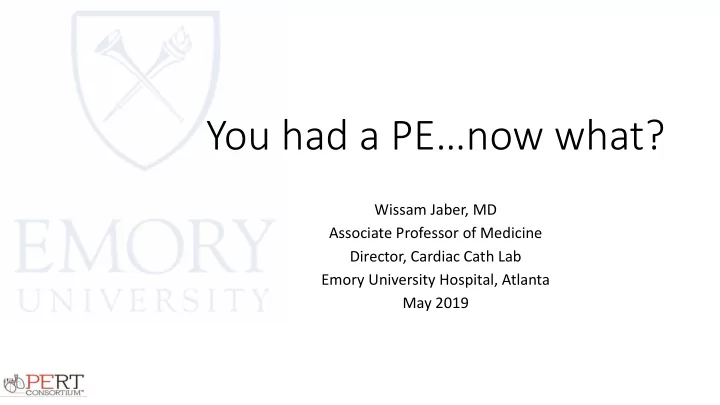

You had a PE…now what? Wissam Jaber, MD Associate Professor of Medicine Director, Cardiac Cath Lab Emory University Hospital, Atlanta May 2019 • • • •
Disclosures • I have received research funds and consultation fees from Inari Medical • I have received consultation fees from Angiodynamic • • • •
PE Clinic • • • •
Outcome and Prognosis Early period (first 2 weeks): death and recurrent PE. Depends on: • presentation (massive, submassive, subsegmental) • Comorbidities Late period (3 months or more): • death mostly related to comorbidities (cancer, age, COPD, CHF) • Recurrent PE • CTEPH • Functional limitation without pulmonary hypertension • • • •
Cumulative VTE Recurrence Cumulative Bleeding Risk Am J Hematol. 2012 May;87 Suppl 1:S63-7 • • • •
Cumulative incidence of first venous thromboembolism recurrence ( — ), and the hazard of first recurrence per 1000 person-days (- - -) Risk Factors -Ideopathic VTE -Malignancy -Age -Neurologic disease with leg pareses Am J Hematol. 2012 May;87 Suppl 1:S63-7 • • • •
Risk of CTEPH after PE Risk factors: • unprovoked PE • diagnostic delay >2 weeks • RV dysfunction • Previous PE N Engl J Med. 2004;350(22):2257 • • • •
High incidence of Functional Limitations after PE Klok. Blood Reviews 28 (2014): 221-226
Things to monitor for in follow up • Anticoagulation • Bleeding risk • Recurrence • Progressive dyspnea/CTEPH, and need for appropriate testing • The need for IVC filter removal • Assess risk of recurrence and duration of anticoagulation • ?Thrombophilia testing • • • •
Follow-Up Algorithm Acute PE Follow-Up Transition of Care Plan Follow Up 2 Weeks to 3 Months After Acute PE Consider: • Anticoagulation: Type, Dose, Duration, Compliance, and Tolerance • IVC Filter Removal • Thrombophilia Work Up • Age-Appropriate Cancer Screening (as indicated) Persistent Symptoms? (dyspnea, fatigue, NO YES lightheadedness, edema) RV Abnormal NO YES at PE Diagnosis? TTE, 6MWT, Consider V/Q If Any If All ABNORMAL Scan and/or NORMAL CPET Evaluate for other No Further Consider Referral for CTEPH causes of dyspnea Follow Up Evaluation Fig 4
• • • • Persistent Symptoms? (dyspnea, fatigue, NO YES lightheadedness, edema) RV Abnormal NO YES at PE Diagnosis? TTE, 6MWT, Consider V/Q If Any If All ABNORMAL Scan and/or NORMAL CPET Evaluate for other No Further Consider Referral for CTEPH causes of dyspnea Follow Up Evaluation Fig 4
How well do we follow up on patients? Disease monitoring in the 2-year period following incident PE Tapson, et al. Am J of Med. 2016 Sep;129(9):978 • • • •
Thrombophilia testing • Identification of high risk thrombophilias: • APLA, homozygous FVL, and combination defects • Potential to inform family members • Important to remember that family history of thrombosis even in the absence of a specific thrombophilia carries an increased risk of VTE in first degree relatives • None of these inherited thrombophilias would lead to the use of primary prevention with anticoagulation outside of high-risk situations • NOT in the acute setting • Most of the time it is not needed even at follow up • • • •
LENGTH OF ANTICOAGULATION Venous thromboembolism Bleeding (VTE) Patient preference • • • •
LENGTH OF ANTICOAGULATION • First Provoked: 3 months • Recurrent provoked: 3 months with prophylaxis around high risk situations • Recurrent unprovoked: Indefinite with periodic reassessment of bleeding risk Antithrombotic therapy for VTE. Chest Guidelines Uptade 2016 • • • •
Presence of high- Low or moderate risk thrombophilia bleeding risk Consider : Extended duration Prediction rules (Grade 2B) Gender First D-dimer unprovoked VTE Age Obesity Mobility Cancer High bleeding risk Patient 3 months (Grade 1B) preference Adapted from Antithormbotic therapy for VTE. Chest Guidelines Uptade 2016 • • • •
Thank you
Recommend
More recommend